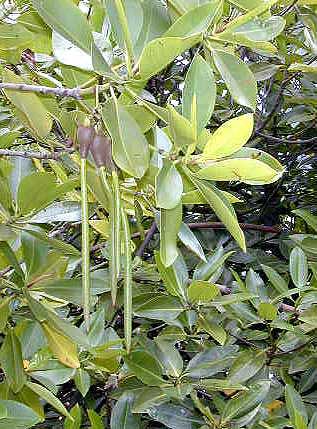
|
THE MANGROVE FOREST In 1953, the botanist Hatheway described the mangrove vegetation on Arno. In most cases, mangrove plants were found in shallow embankments or tidal flats that opened on to the lagoon. However, in one case an embankment had been closed off by drifting sand. Here the mangrove forest formed only a ring of trees bordering a shallow depression that became flooded with salt water at high tide. Hatheway described this kind of mangrove stand:
Although mangrove forests are relatively rare in the Marshall Islands, the plants of these forests, especially those of the larger islands of the tropical Pacific, are important natural components of the environment, or ecosystem. For example, on the higher islands of Micronesia, such as Pohnpei and Kosrae, mangrove trees help stabilize coastal areas by trapping and holding sediment washed down or out from inland areas. In some areas, the mass of tangled roots of the woody mangroves prevent much of this mud from washing out and smothering the coral reefs. Mangrove forests growing along the seashore also offer some coastal protection from normal wave action and strong storm surges. As "producers," the mangrove plants convert energy from the sun into useful carbohydrates and proteins through the process of photosynthesis. These substances are then stored in the leaves or other parts of the plant. Eventually these plant parts drop off into the water and decompose. These materials are then carried out with the tides to the near shore waters as a rich "nutrient soup." This soup serves as an important source of food for reef animals, and for the animals living within the mangrove swamps. These swamps also serve as nurseries for many kinds (species) of young shellfish, finfish and birds. Mangrove trees must have a special means of obtaining oxygen because their roots become submerged in water when the tide comes in. This blocks the usual route of oxygen absorption -- through the roots. Some woody mangrove plants have roots above the ground, for example eoeak or būļabōļ (Rhizophora mucronata). These aerial prop roots have air canals that allow the trees and shrubs to absorb oxygen. Eoeak or būļabōļ (Rhizophora mucronata) can be identified quite easily by their aerial prop roots. Other mangroves, such as būļabōļ (Sonneratia alba) and kimeme (Lumnitzera littorea) can be recognized by exposed, cone- or pencil- shaped roots (pneumatophores) that stick up through the muddy soil from extensive, cable-like rootstock. Joñ (Bruguiera gymnorrhiza), which is shown color plate #4, represented in the diagram below, has spreading, knobby (or "bent-knee") breathing roots. A number of plant species can be found growing in the mangrove forests of the Marshall Islands. Together, as noted earlier, these specially adapted plants form a vegetation zone in some of the Marshall Islands, in depression areas behind the coastal strand of sand or coral rubble. The most common woody plants in the mangrove forests are listed below. Notice that there is a Marshallese name and scientific name for each species, but these four different species are all referred to by the same name in English because the English name is less specific and includes all types of mangrove. However, in some English speaking areas, mangrove species are separated according to their color; for example, red mangrove, white mangrove, black mangrove, and others.
The mangrove vegetation can be divided into different zones from the edge of land out into the lagoon, or from the shore out onto the muddy reef flat. First, there is the intertidal border zone where the coastal forest and mangrove plants meet. It is a narrow zone along the high tide line with little or sometimes no vegetation. This zone usually has shallow mud deposits with patches of shrubs and trees. Some muddy areas in this zone emerge at low tide. This inner margin of the mangrove forest is usually quiet and protected. It is an important type of environment to collect atūñ, the mangrove crab (Scylla serrata). This valuable animal resource is a popular tropical Pacific Island food. Eoeak or būļabōļ (Rhizophora mucronata), a prop-rooted mangrove tree, is relatively common. In many areas, the trees of the mangrove forests provide raw materials for several purposes, including building materials, wood fuel, craft wood, charcoal, resins, and bark products. Unfortunately, in many parts of the tropical world, mangrove forests are being destroyed by over-cutting, dredging for land reclamation projects, and by upslope forest clearing. Notes on the plants of the mangrove forests are included in Chapter III where the plants |
||||||||||||||||||||||||
|| Home || Vegetation Zones || Main Plants || Legends & Fun Facts || Photo Gallery || Cool Links || Email Us || |
||||||||||||||||||||||||
